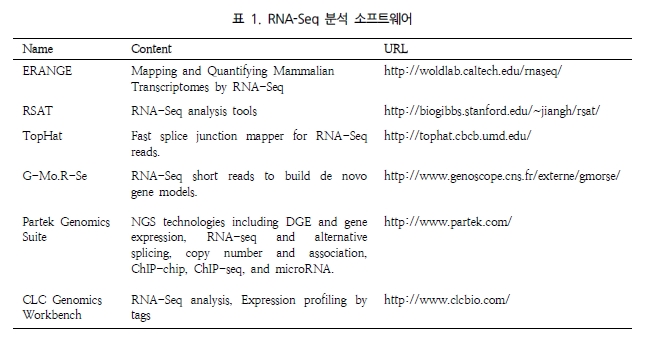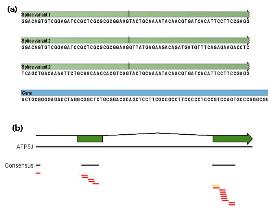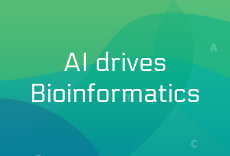[Quipu Issue Paper] Expression Study Ⅵ- RNA-Seq Analysis
- Posted at 2010/03/04 08:59
- Filed under 생물정보
연재 순서
1. Assembly
2. Variation study
3. Expression study
4. Epigenomics
5. Genome Annotation
6. Next Generation Bioinformatics
7. Data Management for web 2.0 Era
8. Semantic Network for Integrated Biology Data
9. Gene Network Discovery by Text-mining
10. Centralization for High-throughput Data Analysis
이번 연재에서는 Next Generation Sequencing의 두 번째 Application인 Expression study 중에 유전자와 엑손의 발현 및 발현된 유전자의 각종 변이 등을 한 번에 연구할 수 있는 RNA-Seq 분석에 대해 알아보겠습니다.
Serial Analysis of gene Expression(SAGE), Cap Analysis of gene expression (CAGE), 그리고 Massively Parallel Signature sequencing(MPSS)은 특정 유전자의 발현 양 정보를 얻고자 하는 목표로 수행되는 방법들이다. 이러한 방법들은 많이 이용되고 있지만 Sanger 방법에 바탕을 둔 것으로 높은 비용과 짧은 reads는 reference 서열에 유일하게 매핑하기 힘들다는 문제점을 가지고 있다. 이러한 문제점들을 극복하기 위한 방법으로는 유전자와 엑손의 발현 및 발현된 유전자의 각종 변이 등을 한 번에 연구할 수 있는 RNA-Seq기술이 있다[1].
표 1에서 보는 것과 같이 RNA-Seq을 분석 할 수 있는 프로그램에는 여러 가지 소프트웨어가 있는데 그 중에 CLC Genomics Workbench는 annotation된 Reference 유전체 서열과 mRNA 시퀀싱 reads를 바탕으로 새로운 엑손의 발굴뿐만 아니라 유전자 발현 레벨을 계산할 수 있다. RNA-Seq 분석은 몇 가지 단계로 수행된다. 먼저, Reference 서열에서 모든 유전자를 추출한다. 이 때 유전자 서열의 다른 annotation들은 보존된다[23].
 다음으로 영역 주변의 엑손-엑손 경계를 추출한다. 그 다음으로 모든 엑손-엑손 junctions plus에 대한 Reference assembly가 수행된다. 이 assembly로부터 각각의 유전자에 대해 발현 수치가 계산되고 putative exon을 확인할 수 있다. 발현 수치는 RPKM(reads per kilobase of exon model per milion mapped reads)방법으로 측정된다(그림 9).
다음으로 영역 주변의 엑손-엑손 경계를 추출한다. 그 다음으로 모든 엑손-엑손 junctions plus에 대한 Reference assembly가 수행된다. 이 assembly로부터 각각의 유전자에 대해 발현 수치가 계산되고 putative exon을 확인할 수 있다. 발현 수치는 RPKM(reads per kilobase of exon model per milion mapped reads)방법으로 측정된다(그림 9).
 그림 9. RNA_seq analysis.
그림 9. RNA_seq analysis.
1. Assembly
2. Variation study
3. Expression study
4. Epigenomics
5. Genome Annotation
6. Next Generation Bioinformatics
7. Data Management for web 2.0 Era
8. Semantic Network for Integrated Biology Data
9. Gene Network Discovery by Text-mining
10. Centralization for High-throughput Data Analysis
이번 연재에서는 Next Generation Sequencing의 두 번째 Application인 Expression study 중에 유전자와 엑손의 발현 및 발현된 유전자의 각종 변이 등을 한 번에 연구할 수 있는 RNA-Seq 분석에 대해 알아보겠습니다.
2-2-6. RNA-Seq Analysis
Serial Analysis of gene Expression(SAGE), Cap Analysis of gene expression (CAGE), 그리고 Massively Parallel Signature sequencing(MPSS)은 특정 유전자의 발현 양 정보를 얻고자 하는 목표로 수행되는 방법들이다. 이러한 방법들은 많이 이용되고 있지만 Sanger 방법에 바탕을 둔 것으로 높은 비용과 짧은 reads는 reference 서열에 유일하게 매핑하기 힘들다는 문제점을 가지고 있다. 이러한 문제점들을 극복하기 위한 방법으로는 유전자와 엑손의 발현 및 발현된 유전자의 각종 변이 등을 한 번에 연구할 수 있는 RNA-Seq기술이 있다[1].
표 1에서 보는 것과 같이 RNA-Seq을 분석 할 수 있는 프로그램에는 여러 가지 소프트웨어가 있는데 그 중에 CLC Genomics Workbench는 annotation된 Reference 유전체 서열과 mRNA 시퀀싱 reads를 바탕으로 새로운 엑손의 발굴뿐만 아니라 유전자 발현 레벨을 계산할 수 있다. RNA-Seq 분석은 몇 가지 단계로 수행된다. 먼저, Reference 서열에서 모든 유전자를 추출한다. 이 때 유전자 서열의 다른 annotation들은 보존된다[23].


(a) exon-exon junction+gene 서열을 reference 서열로 한다.
(b) NGS reads의 reference assembly를 통한 alignment를 통해
새로운 각 엑손 단위 혹은 유전자 단위의 발현양을 확인한다.
다음 연재에서는 한정적인 유전자를 좀 더 다양하게 활용할 수 있는 Alternative splicing 분석에 대해 알아보겠습니다. 많은 관심 부탁드립니다.
참고문헌
1. Mortazavi A, Williams BA, McCue K, Schaeffer L, Wold B. (2008) Mapping and quantifying mammalian transcriptomes by RNA-Seq. Nat Methods. 7, 621-628.
2. Fei Z, Tang X, Alba RM, White JA, Ronning CM, Martin GB, Tanksley SD, Giovannoni JJ. (2004) Comprehensive EST analysis of tomato and comparative genomics of fruit ripening. Plant J. 40, 47–59
3. Rensink WA, Lee Y, Liu J, Iobst S, Ouyang S, Buell CR. (2005) Comparative analyses of six solanaceous transcriptomes reveal a high degree of sequence conservation and species-specific transcripts. BMC Genomics. 6, 124
4. Ronning,C.M. et al. (2003) Comparative analyses of potato expressed sequence tag libraries. Plant Physiol. 131, 419–429
5. Guo J, Zhu P, Wu C, Yu L, Zhao S, Gu X. (2003) In silico analysis indicates a similar gene expression pattern between human brain and testis. Cytogenet Genome Res. 103, 58-62
6. Benjamini, Y., Daniel Yekutieli. (2001) The control of the false discovery rate in multiple hypotheses testing under dependency. Annal. Stat. 4(29), 1165–1188
7. Tsai CA, Hsueh HM, Chen JJ. (2003) Estimation of false discovery rates in multiple testing: application to gene microarray data. Biometrics. 59, 1071-81
8. Audic S, Claverie JM. (1997) The significance of digital gene expression profiles. Genome Res. 7, 986–995
9. Roche 454 : Products & Solutions - Multiplexing
(http://www.454.com/products-solutions/experimental-design-options/multiplexing.asp)
10. Tatusov RL, Koonin EV, Lipman DJ. (1997) A genomic perspective on protein families. Science. 278, 631-637
11. Kato T, Murata Y, Miura K, Asai K, Horton PB, Koji T, Fujibuchi W. (2006) Network-based de-noising improves prediction from microarray data, BMC Bioinformatics. 7, S4
12. Noh SJ, Lee K, Paik H, Hur CG. (2006) TISA: tissue-specific alternative splicing in human and mouse genes. DNA Res. 5, 229-243
13. Zeeberg BR, Feng W, Wang G, Wang MD, Fojo AT, Sunshine M, Narasimhan S, Kane DW, Reinhold WC, Lababidi S, Bussey KJ, Riss J, Barrett JC, Weinstein JN. (2003) GoMiner: a resource for biological interpretation of genomic and proteomic data, Genome Biol. 4, R28
14. GeneSpring GX : Products & Services - GeneSpring GX Software
(http://www.chem.agilent.com/en-US/products/software/lifesciencesinformatics/genespringgx/pages/default.aspx)
15. Wingender E, Chen X, Hehl R, Karas H, Liebich I, Matys V, Meinhardt T, Prüss M, Reuter I, Schacherer F. (2000) TRANSFAC: an integrated system for gene expression regulation. Nucleic Acids Research. 28, 316-319
16. PathwayStudio : Products-pathway Studio
(http://www.ariadnegenomics.com/products/pathwaystudio/)
17. Eveland AL, McCarty DR, Koch KE. (2007) Transcript profiling by 3'-untranslated region sequencing resolves expression of gene families. Plant Physiol. 146, 32-44.
18. Torres TT, Metta M, Ottenwälder B, Schlötterer C. (2008) Gene expression profiling by massively parallel sequencing. Genome Res. 1, 172-7.
19. Vega-Arreguín JC, Ibarra-Laclette E, Jiménez-Moraila B, Martínez O, Vielle-Calzada JP, Herrera-Estrella L, Herrera-Estrella A. (2009) Deep sampling of the Palomero maize transcriptome by a high throughput strategy of pyrosequencing. BMC Genomics. 10, 299.
20. Wang ET, Sandberg R, Luo S, Khrebtukova I, Zhang L, Mayr C, Kingsmore SF, Schroth GP, Burge CB. (2008) Alternative isoform regulation in human tissue transcriptomes. Nature. 2456, 70-76.
21. Johnson JM, Castle J, Garrett-Engele P, Kan Z, Loerch PM, Armour CD, Santos R, Schadt EE, Stoughton R, Shoemaker DD. (2003) Genome-wide survey of human alternative pre-mRNA splicing with exon junction microarrays. Science. 302, 2141-2144.
22. Ledford H. (2008) Human genes are multitaskers. Nature. 456, 9.
23. CLC Genomics Workbench: RNA-Seq analysis
(http://www.clcbio.com/index.php?id=1330&manual=RNA_Seq_analysis.html)
(b) NGS reads의 reference assembly를 통한 alignment를 통해
새로운 각 엑손 단위 혹은 유전자 단위의 발현양을 확인한다.
다음 연재에서는 한정적인 유전자를 좀 더 다양하게 활용할 수 있는 Alternative splicing 분석에 대해 알아보겠습니다. 많은 관심 부탁드립니다.
참고문헌
1. Mortazavi A, Williams BA, McCue K, Schaeffer L, Wold B. (2008) Mapping and quantifying mammalian transcriptomes by RNA-Seq. Nat Methods. 7, 621-628.
2. Fei Z, Tang X, Alba RM, White JA, Ronning CM, Martin GB, Tanksley SD, Giovannoni JJ. (2004) Comprehensive EST analysis of tomato and comparative genomics of fruit ripening. Plant J. 40, 47–59
3. Rensink WA, Lee Y, Liu J, Iobst S, Ouyang S, Buell CR. (2005) Comparative analyses of six solanaceous transcriptomes reveal a high degree of sequence conservation and species-specific transcripts. BMC Genomics. 6, 124
4. Ronning,C.M. et al. (2003) Comparative analyses of potato expressed sequence tag libraries. Plant Physiol. 131, 419–429
5. Guo J, Zhu P, Wu C, Yu L, Zhao S, Gu X. (2003) In silico analysis indicates a similar gene expression pattern between human brain and testis. Cytogenet Genome Res. 103, 58-62
6. Benjamini, Y., Daniel Yekutieli. (2001) The control of the false discovery rate in multiple hypotheses testing under dependency. Annal. Stat. 4(29), 1165–1188
7. Tsai CA, Hsueh HM, Chen JJ. (2003) Estimation of false discovery rates in multiple testing: application to gene microarray data. Biometrics. 59, 1071-81
8. Audic S, Claverie JM. (1997) The significance of digital gene expression profiles. Genome Res. 7, 986–995
9. Roche 454 : Products & Solutions - Multiplexing
(http://www.454.com/products-solutions/experimental-design-options/multiplexing.asp)
10. Tatusov RL, Koonin EV, Lipman DJ. (1997) A genomic perspective on protein families. Science. 278, 631-637
11. Kato T, Murata Y, Miura K, Asai K, Horton PB, Koji T, Fujibuchi W. (2006) Network-based de-noising improves prediction from microarray data, BMC Bioinformatics. 7, S4
12. Noh SJ, Lee K, Paik H, Hur CG. (2006) TISA: tissue-specific alternative splicing in human and mouse genes. DNA Res. 5, 229-243
13. Zeeberg BR, Feng W, Wang G, Wang MD, Fojo AT, Sunshine M, Narasimhan S, Kane DW, Reinhold WC, Lababidi S, Bussey KJ, Riss J, Barrett JC, Weinstein JN. (2003) GoMiner: a resource for biological interpretation of genomic and proteomic data, Genome Biol. 4, R28
14. GeneSpring GX : Products & Services - GeneSpring GX Software
(http://www.chem.agilent.com/en-US/products/software/lifesciencesinformatics/genespringgx/pages/default.aspx)
15. Wingender E, Chen X, Hehl R, Karas H, Liebich I, Matys V, Meinhardt T, Prüss M, Reuter I, Schacherer F. (2000) TRANSFAC: an integrated system for gene expression regulation. Nucleic Acids Research. 28, 316-319
16. PathwayStudio : Products-pathway Studio
(http://www.ariadnegenomics.com/products/pathwaystudio/)
17. Eveland AL, McCarty DR, Koch KE. (2007) Transcript profiling by 3'-untranslated region sequencing resolves expression of gene families. Plant Physiol. 146, 32-44.
18. Torres TT, Metta M, Ottenwälder B, Schlötterer C. (2008) Gene expression profiling by massively parallel sequencing. Genome Res. 1, 172-7.
19. Vega-Arreguín JC, Ibarra-Laclette E, Jiménez-Moraila B, Martínez O, Vielle-Calzada JP, Herrera-Estrella L, Herrera-Estrella A. (2009) Deep sampling of the Palomero maize transcriptome by a high throughput strategy of pyrosequencing. BMC Genomics. 10, 299.
20. Wang ET, Sandberg R, Luo S, Khrebtukova I, Zhang L, Mayr C, Kingsmore SF, Schroth GP, Burge CB. (2008) Alternative isoform regulation in human tissue transcriptomes. Nature. 2456, 70-76.
21. Johnson JM, Castle J, Garrett-Engele P, Kan Z, Loerch PM, Armour CD, Santos R, Schadt EE, Stoughton R, Shoemaker DD. (2003) Genome-wide survey of human alternative pre-mRNA splicing with exon junction microarrays. Science. 302, 2141-2144.
22. Ledford H. (2008) Human genes are multitaskers. Nature. 456, 9.
23. CLC Genomics Workbench: RNA-Seq analysis
(http://www.clcbio.com/index.php?id=1330&manual=RNA_Seq_analysis.html)
Posted by 人Co
- Tag
- CAGE, CLC Genomics Workbench, insilicogen, MPSS, NGS, putative exon, RNA-Seq, RPKM, SAGE, 엑손, 인실리코젠
- Response
- No Trackback , No Comment
- RSS :
- https://post-blog.insilicogen.com/blog/rss/response/51


